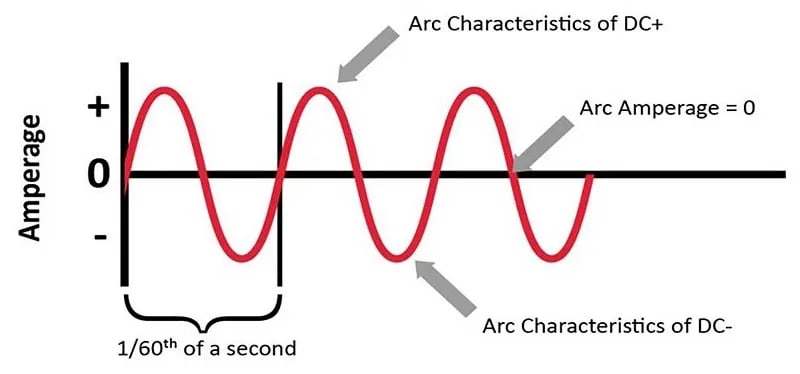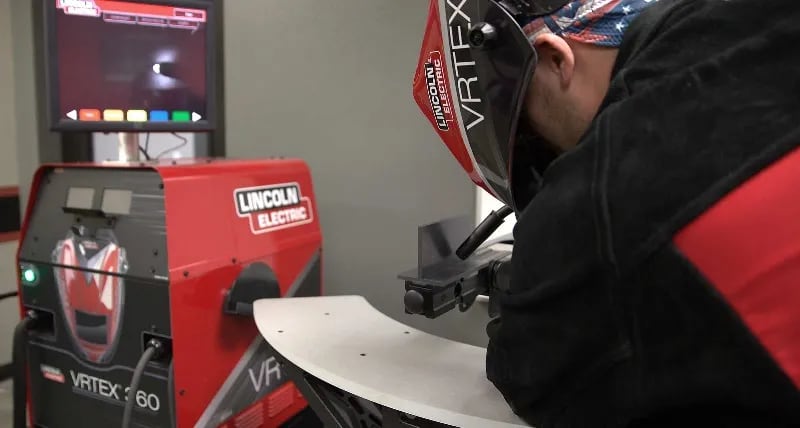Average Welder Salaries by Industry, Location & Experience
Discover average welding pay, pipeline welder salary, rig welder salary, highest paying welding jobs and more. Find out how much welders make.
If you ever step foot in a welding shop or take a welding course, you’ll probably hear the term “polarity.” But what is the polarity welding definition and how is it applied in the welding industry?
Polarity in welding refers to the positive or negative pole of the electrical circuit formed when a welding machine is turned on. Polarity is crucial in determining the quality and strength of the weld, and choosing the wrong polarity can lead to issues such as ineffective penetration and spattering.
There are two main types of welding — AC (alternating current) and DC (direct current) — each with its own polarity characteristics. DC welding, which offers benefits such as easier arc striking and reduced spatter, is commonly used in shielded metal arc welding (SMAW).
Understanding the different types of polarity — including direct current straight polarity, direct current reverse polarity and alternating current polarity — is important for welders to achieve the desired results in their projects.
Polarity is what determines the strength and quality of the weld. No two projects are exactly alike, and polarity must be adjusted for each material depending on the desired outcome. Keep reading to learn all about polarity in welding — what it is, how it works, the different types and more.
When you turn on a welding machine, an electrical circuit is formed. The circuit has either a positive or negative pole, and this property is referred to as polarity.
Polarity is critical for welders to understand because it directly impacts the quality and strength of the weld. If a welder chooses the wrong polarity, problems can arise, like ineffective penetration, spattering and loss of control of the welding arc.
So, what is polarity welding and how does it work? When you’re welding, there’s an electrical circuit that is created when you turn on the machine. It has a negative and a positive pole, which is what polarity is.
Polarity is extremely important to be aware of if you want to learn how to weld because it affects the strength and quality of your weld. If you use the wrong polarity, it could create a lot of issues while welding such as a lack of control and spatter.
Welding machines and electrodes are typically labeled AC or DC, which is what indicates the polarity of the current in the machine. AC stands for alternating current, and DC stands for direct current.
DC flows in one direction, which results in constant polarity. AC flows half the time in one direction and half the time in the other, changing its polarity 120 times per second with a 60-hertz current. If you look at a welding machine that is labeled DC, this means it has constant polarity, and if it’s labeled AC, the polarity will change.

So how are AC and DC welding used?
It’s important for a welder to know the meaning of polarity and understand how it affects the welding process. Typically, electrode-positive (reversed polarity) welding results in deeper penetration. Electrode-negative (straight polarity) welding results in faster melt-off of the electrode, and therefore a faster deposition rate. Deposition rate refers to the amount of filler metal melted into the weld joint.
DC welding offers many benefits, making it a popular choice in shielded metal arc welding (SMAW). This method allows you to strike the arc easier and makes for a smooth, stable arc. It also reduces spatter and the chance for outages to occur and can help you avoid complications when overhead or vertical welding.
On the other hand, AC welding is often used with low-cost, entry-level machinery, making it a good choice for welding training. Many welders prefer it in conditions where the arc can blow side-to-side.
There are three main types of polarity: direct current straight polarity, direct current reverse polarity and alternating current polarity.
Direct current straight polarity welding happens when the plates are positive and the electrode is negative. This causes the electrons to go from the electrode tip to the base plates.
It’s generally considered that two-thirds (66%) of the entire arc heat is generated at the electrode, whereas only one-third (33%) of the heat is generated at the base plate. As a result, the electrode melts down quickly and the metal deposition rate increases (for consumable electrodes only).
On the other hand, base plates tend to not fuse properly due to lack of sufficient heat. Therefore various defects arise, such as insufficient fusion, lack of penetration and high reinforcement. Weld reinforcement is a term used to describe metal in excess of that needed to fill a joint.
When the electrode is positive and the plates are negative, this results in direct current reverse polarity. The electrons switch directions and go from the base plates to the electrode. Consequently, more heat generates at the base plate as compared with DC straight polarity.
This type of welding is less likely to cause inclusion defects (nonmetallic particles trapped in the weld metal or at the weld interface) due to its arc cleaning action. It makes for faster welding and performs better for welding thin pieces of material. It’s commonly chosen for joining metals like copper, which has a low melting point.
The potential downside to this type of welding is that it has a shorter electrode life. If the speed isn’t set correctly, there is a high level of reinforcement needed. While it works great for thinner materials, this method may be ineffective for joining thick plates with higher melting points.
If an AC current is supplied by the power source, reverse and straight polarity will take place one after the other. In half the cycle, the base plates will be positive, and the electrode will be negative. In the other half, the electrode will be positive, and the base plates will be negative.
Depending on frequency of supply, this cycle repeats 50 to 60 times per second. Some power sources also provide provisions, which can alter frequency.
AC polarity has attributes of straight and reverse polarity since both are occurring in the same cycle. It is effective to use with most electrode types and is suitable for many different plate thicknesses, making it a great all-around choice.
At this point you might be wondering, “How do you select polarity?” When making this decision, there are several factors to consider, such as the melting point and thickness of the material.

For example, magnesium and aluminum work better with reverse polarity, as their melting points are low. For stainless steel or titanium, alternating current polarity might be a better choice since it provides the benefits of straight and reverse polarity while keeping the heat-affected zone from becoming too large.
As welders learn to work with different materials, they become more familiar with the types of polarity that should be used. This is all part of learning the craft!
Are you interested in learning more about polarity and how to work with different types of welding equipment? A career in welding may be the right choice.
Some welders choose to train on the job, but many employers prefer to hire welders who have completed a formal training program, such as Universal Technical Institute’s Welding Technology program.1 Created in conjunction with Lincoln Electric, this program is designed to equip students with the skills needed to become a welder in today’s world.
In just 36 weeks, students can train to become combination welders by learning four different welding processes:
By the end of the program, students are well-prepared to pursue career opportunities in the field. They can take advantage of the resources provided by UTI’s Career Services team, which collaborates with employers of all sizes across the country to identify potential jobs for graduates.
UTI’s welding program begins frequently, so you can get going and start preparing for a career sooner. To learn more, request information to get in touch with an Admissions Representative today.
Universal Technical Institute of Illinois, Inc. is approved by the Division of Private Business and Vocational Schools of the Illinois Board of Higher Education.